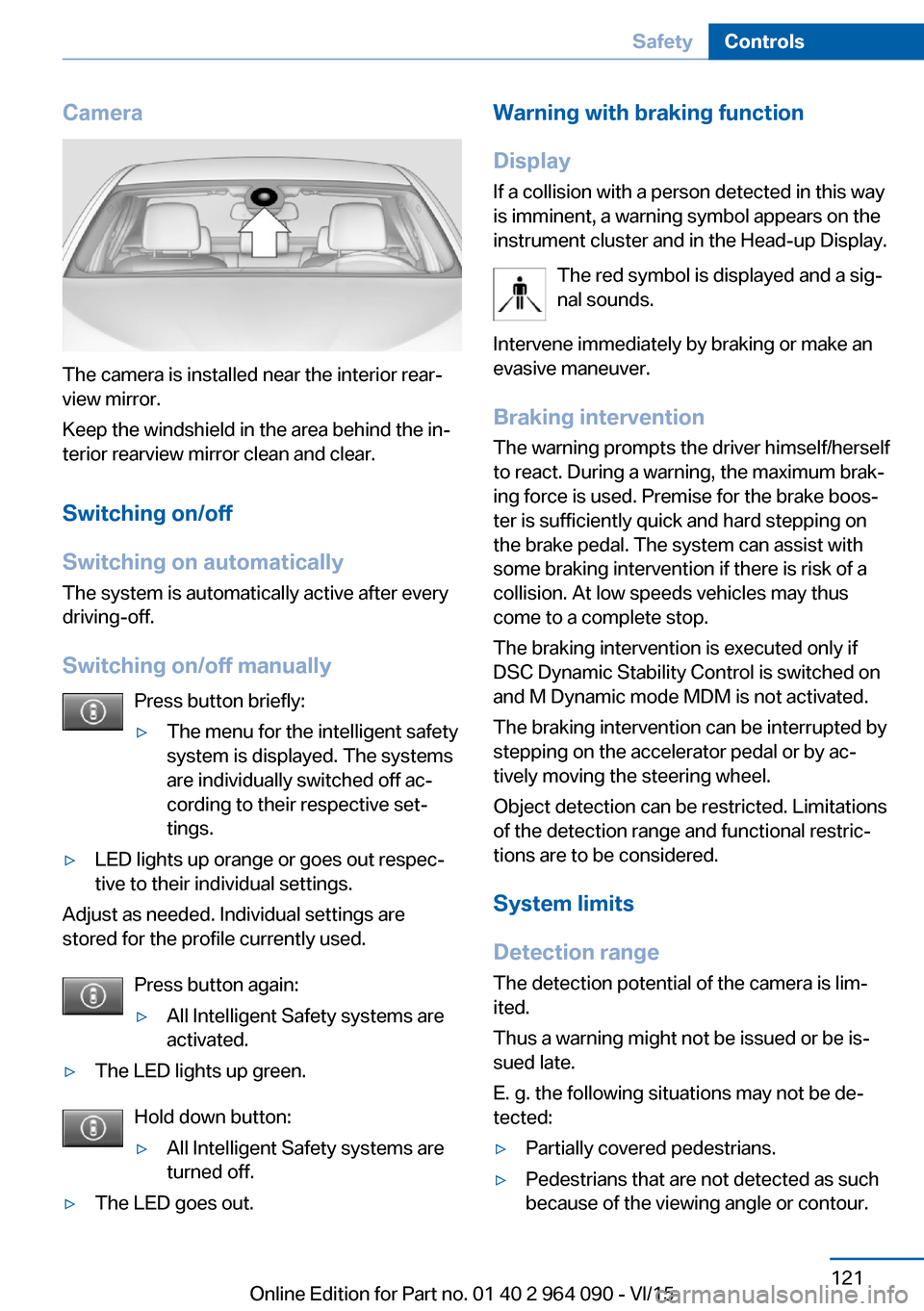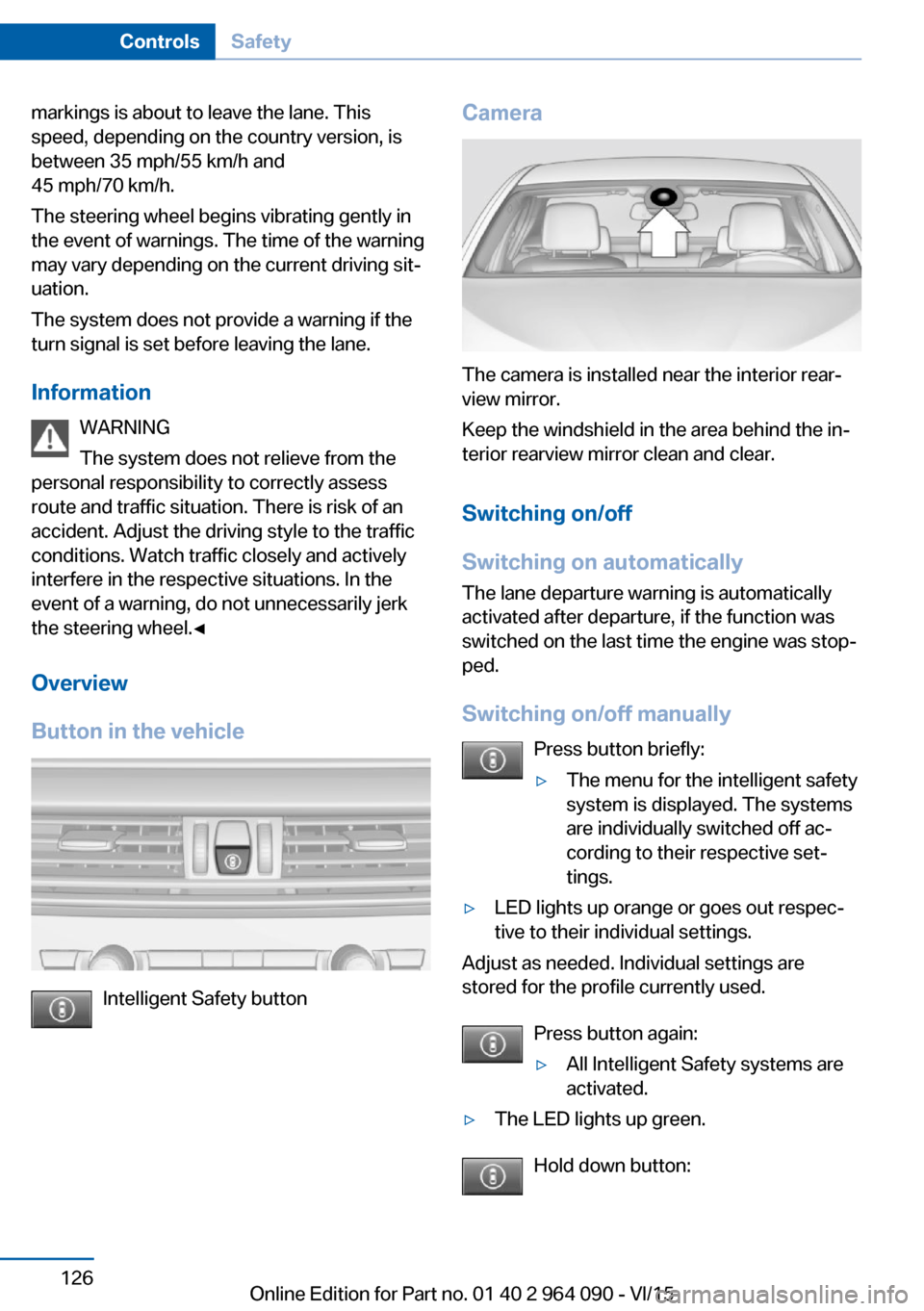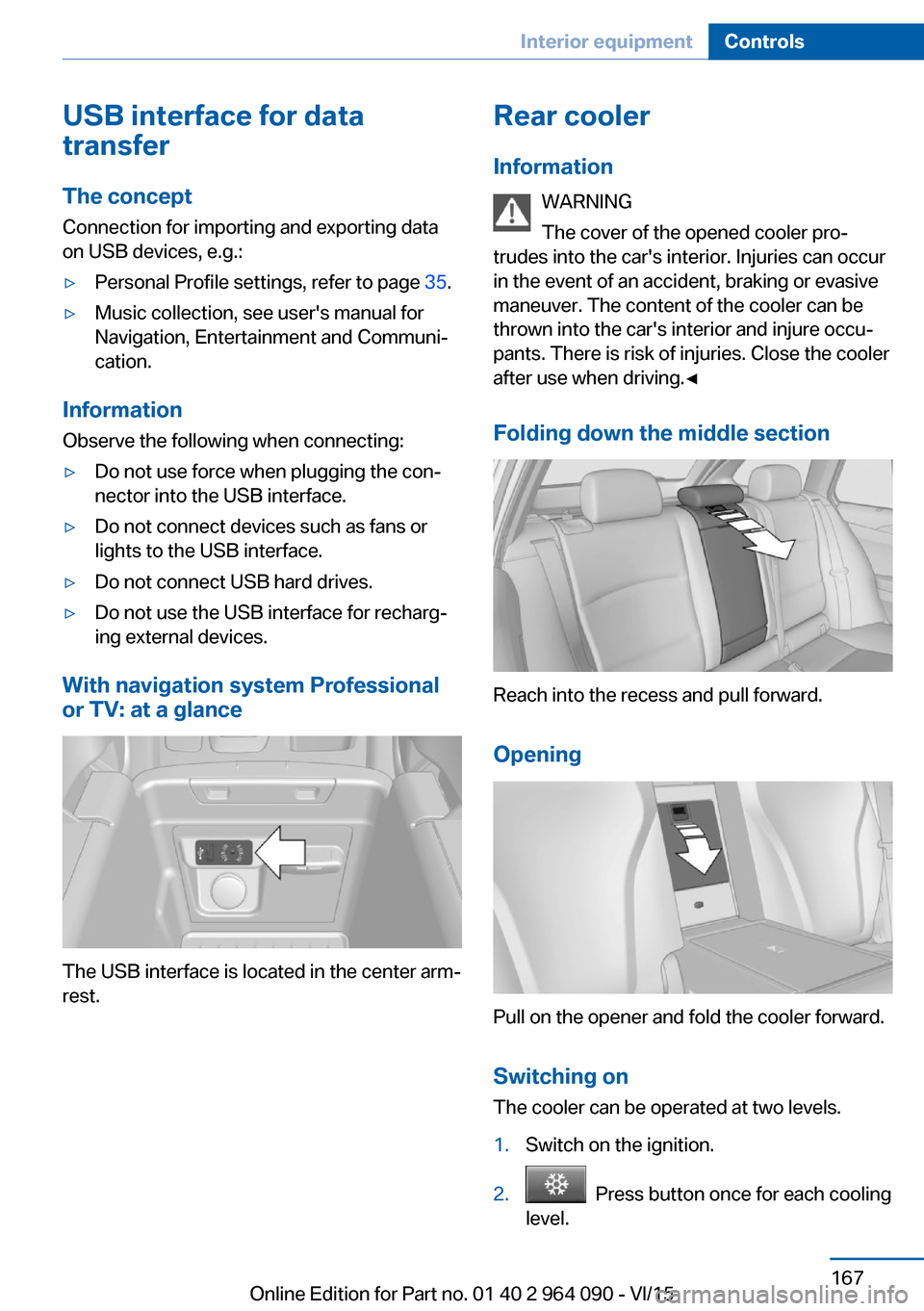2015 BMW X5M interior lights
[x] Cancel search: interior lightsPage 121 of 255

Camera
The camera is installed near the interior rear‐
view mirror.
Keep the windshield in the area behind the in‐
terior rearview mirror clean and clear.
Switching on/off
Switching on automatically The system is automatically active after every
driving-off.
Switching on/off manually Press button briefly:
▷The menu for the intelligent safety
system is displayed. The systems
are individually switched off ac‐
cording to their respective set‐
tings.▷LED lights up orange or goes out respec‐
tive to their individual settings.
Adjust as needed. Individual settings are
stored for the profile currently used.
Press button again:
▷All Intelligent Safety systems are
activated.▷The LED lights up green.
Hold down button:
▷All Intelligent Safety systems are
turned off.▷The LED goes out.Warning with braking function
Display
If a collision with a person detected in this way
is imminent, a warning symbol appears on the
instrument cluster and in the Head-up Display.
The red symbol is displayed and a sig‐
nal sounds.
Intervene immediately by braking or make an
evasive maneuver.
Braking intervention
The warning prompts the driver himself/herself
to react. During a warning, the maximum brak‐
ing force is used. Premise for the brake boos‐
ter is sufficiently quick and hard stepping on
the brake pedal. The system can assist with
some braking intervention if there is risk of a
collision. At low speeds vehicles may thus
come to a complete stop.
The braking intervention is executed only if
DSC Dynamic Stability Control is switched on
and M Dynamic mode MDM is not activated.
The braking intervention can be interrupted by
stepping on the accelerator pedal or by ac‐
tively moving the steering wheel.
Object detection can be restricted. Limitations
of the detection range and functional restric‐
tions are to be considered.
System limits
Detection range
The detection potential of the camera is lim‐
ited.
Thus a warning might not be issued or be is‐
sued late.
E. g. the following situations may not be de‐
tected:▷Partially covered pedestrians.▷Pedestrians that are not detected as such
because of the viewing angle or contour.Seite 121SafetyControls121
Online Edition for Part no. 01 40 2 964 090 - VI/15
Page 126 of 255

markings is about to leave the lane. This
speed, depending on the country version, is
between 35 mph/55 km/h and
45 mph/70 km/h.
The steering wheel begins vibrating gently in
the event of warnings. The time of the warning
may vary depending on the current driving sit‐
uation.
The system does not provide a warning if the
turn signal is set before leaving the lane.
Information WARNING
The system does not relieve from the
personal responsibility to correctly assess
route and traffic situation. There is risk of an
accident. Adjust the driving style to the traffic
conditions. Watch traffic closely and actively interfere in the respective situations. In the
event of a warning, do not unnecessarily jerk
the steering wheel.◀
Overview
Button in the vehicle
Intelligent Safety button
Camera
The camera is installed near the interior rear‐
view mirror.
Keep the windshield in the area behind the in‐
terior rearview mirror clean and clear.
Switching on/off
Switching on automatically The lane departure warning is automatically
activated after departure, if the function was
switched on the last time the engine was stop‐
ped.
Switching on/off manually Press button briefly:
▷The menu for the intelligent safety
system is displayed. The systems
are individually switched off ac‐
cording to their respective set‐
tings.▷LED lights up orange or goes out respec‐
tive to their individual settings.
Adjust as needed. Individual settings are
stored for the profile currently used.
Press button again:
▷All Intelligent Safety systems are
activated.▷The LED lights up green.
Hold down button:
Seite 126ControlsSafety126
Online Edition for Part no. 01 40 2 964 090 - VI/15
Page 127 of 255

▷All Intelligent Safety systems are turned
off.▷The LED goes out.
Display in the instrument cluster
▷Lines: system is activated.▷Arrows: at least one lane marking
was detected and warnings can be
issued.
Issued warning
If you leave the lane and if a lane marking has
been detected, the steering wheel begins vi‐
brating.
If the turn signal is set before changing the
lane, a warning is not issued.
End of warning
The warning is canceled in the following situa‐
tions:
▷Automatically after approx. 3 seconds.▷When returning to your own lane.▷When braking hard.▷When using the turn signal.
System limits
The system may not be fully functional in the
following situations:
▷In heavy fog, rain or snowfall.▷In the event of missing, worn, poorly visi‐
ble, merging, diverging, or multiple lane
markings such as in construction areas.▷When lane markings are covered in snow,
ice, dirt or water.▷In tight curves or on narrow lanes.▷When the lane markings are covered by
objects.▷When driving very close to the vehicle in
front of you.▷When driving toward bright lights.▷When the windshield in front of the interior
rearview mirror is fogged over, dirty or cov‐
ered with stickers, etc.▷During calibration of the camera immedi‐
ately after vehicle delivery.
Active Blind Spot Detection
The concept
Two radar sensors in the rear bumper monitor
the area behind and next to the vehicle at
speeds above approx. 30 mph/50 km/h.
The system indicates whether there are vehi‐
cles in the blind spot, arrow 1, or approaching
from behind on the adjacent lane, arrow 2.
The lamp in the exterior mirror housing is dim‐
med.
Before you change lanes after setting the turn
signal, the system issues a warning in the sit‐
uations described above.
The lamp in the exterior mirror housing flashes
and the steering wheel vibrates.
Information WARNING
The system does not relieve from the
personal responsibility to correctly assess visi‐
bility and traffic situation. There is risk of an ac‐
cident. Adjust the driving style to the traffic
conditions. Watch traffic closely and actively interfere in the respective situations.◀
Seite 127SafetyControls127
Online Edition for Part no. 01 40 2 964 090 - VI/15
Page 167 of 255

USB interface for data
transfer
The concept Connection for importing and exporting data
on USB devices, e.g.:▷Personal Profile settings, refer to page 35.▷Music collection, see user's manual for
Navigation, Entertainment and Communi‐
cation.
Information
Observe the following when connecting:
▷Do not use force when plugging the con‐
nector into the USB interface.▷Do not connect devices such as fans or
lights to the USB interface.▷Do not connect USB hard drives.▷Do not use the USB interface for recharg‐
ing external devices.
With navigation system Professional
or TV: at a glance
The USB interface is located in the center arm‐
rest.
Rear cooler
Information WARNING
The cover of the opened cooler pro‐
trudes into the car's interior. Injuries can occur
in the event of an accident, braking or evasive
maneuver. The content of the cooler can be
thrown into the car's interior and injure occu‐
pants. There is risk of injuries. Close the cooler
after use when driving.◀
Folding down the middle section
Reach into the recess and pull forward.
Opening
Pull on the opener and fold the cooler forward. Switching onThe cooler can be operated at two levels.
1.Switch on the ignition.2. Press button once for each cooling
level.
Seite 167Interior equipmentControls167
Online Edition for Part no. 01 40 2 964 090 - VI/15
Page 175 of 255

Opening
Push the cover down slightly and press the
button, see arrow. The respective cover folds
up.
ClosingFold the respective cover down until it latches.
Connection for an external audio
device
An external audio device, e.g.,
an MP3 player, can be con‐
nected via the AUX-IN port or
the USB audio interface in the
center armrest.
BMW X6 M: rear
Overview A storage compartment is located in the centerarmrest between the seats.
Opening
1.Pull the loop and fold down the center arm‐
rest.2.Pull the handle.
Closing
Press cover down until it latches.
Glasses compartment Overview
The compartment for eye glasses is located
between the interior mirror and interior lights.
Opening
Press button.
Closing Press the cover up until it latches.
Seite 175Storage compartmentsControls175
Online Edition for Part no. 01 40 2 964 090 - VI/15
Page 246 of 255

Controller 19
Control systems, driving sta‐ bility 132
Convenient opening with the remote control 38
Coolant 216
Coolant temperature 91
Cooler 167
Cooling function 156
Cooling, maximum 156
Cooling system 216
Cornering light 106
Corrosion on brake discs 186
Cosmetic mirror 164
Courtesy lamps during un‐ locking 37
Courtesy lamps with the vehi‐ cle locked 38
Cruise control 140
Cruising range 92
Cupholder 176
Current fuel consumption 93
D
Damage, tires 204
Damping control 137
Data, technical 240
Date 92
Daytime running lights 106
Defrosting, see Windows, de‐ frosting 158
Dehumidifying, air 156
Deleting personal data 24
Deletion of personal data 24
Departure time, parked-car ventilation 161
Destination distance 98
Digital clock 91
Digital speed 92
Digital tachometer 92
Dimensions 240
Dimmable exterior mirrors 62
Dimmable interior rearview mirror 62 Direction indicator, see Turn
signals 76
Display EfficientDynamics 93
Display, electronic, instru‐ ment cluster 86
Display in windshield 101
Display lighting, see Instru‐ ment lighting 108
Displays, cleaning 236
Disposal, coolant 217
Disposal, vehicle battery 226
Distance control, see PDC 142
Distance to destination 98
Divided screen view, split screen 23
Door lock 39
Door lock, see Remote con‐ trol 34
Doors, Automatic Soft Clos‐ ing 40
Downhill control 136
DPC, see Dynamic Perform‐ ance Control 132
Drivelogic 83
Drive mode 81
Drive-off assistant 132
Drive-off assistant, see DSC 134
Driving Dynamics Control 85
Driving instructions, break- in 184
Driving notes, general 184
Driving on bad roads 186
Driving on racetracks 182
Driving program, refer to Drivelogic 83
Driving stability control sys‐ tems 132
Driving tips 184
DSC Dynamic Stability Con‐ trol 134
Dynamic driving systems 93
Dynamic driving, system states 93 Dynamic Performance Con‐
trol DPC 132
Dynamic Stability Control DSC 134
E EfficientDynamics 93
Electronic displays, instru‐ ment cluster 86
Electronic oil measure‐ ment 213
Electronic Stability Program ESP, see DSC 134
Emergency detection, remote control 35
Emergency release, fuel filler flap 196
Emergency release, parking brake 75
Emergency Request 228
Emergency start function, en‐ gine start 35
Emergency unlocking, trans‐ mission lock 84
Emergency wheel 224
Energy Control 93
Energy recovery 93
Engine, automatic Start/Stop function 71
Engine, automatic switch- off 71
Engine compartment 210
Engine compartment, work‐ ing in 211
Engine coolant 216
Engine oil 213
Engine oil, adding 214
Engine oil additives 215
Engine oil change 215
Engine oil filler neck 214
Engine oil temperature 91
Engine oil types, alterna‐ tive 215
Engine oil types, suitable 215 Seite 246ReferenceEverything from A to Z246
Online Edition for Part no. 01 40 2 964 090 - VI/15
Page 247 of 255

Engine start during malfunc‐tion 35
Engine start, jump-start‐ ing 229
Engine start, refer to Starting the engine 70
Engine stop 70
Engine temperature 91
Entering a car wash 233
Equipment, interior 162
Error displays, see Check Control 87
ESP Electronic Stability Pro‐ gram, see DSC 134
Exchanging wheels/tires 204
Exhaust system 185
Exterior mirror, automatic dimming feature 62
Exterior mirrors 61
External start 229
External temperature dis‐ play 91
External temperature warn‐ ing 91
Eyes for securing cargo 189
F
Failure message, see Check Control 87
False alarm, see Unintentional alarm 48
Fan, see Air flow 157
Filler neck for engine oil 214
Fine wood, care 235
First-aid kit 229
Fitting for towing, see Tow fit‐ ting 232
Flat tire, changing wheels 223
Flat Tire Monitor FTM 115
Flat tire, repairing 206
Flat tire, Tire Pressure Moni‐ tor TPM 112
Flat tire, warning lamp 113, 115 Flooding 185
Floor carpet, care 236
Floor mats, care 236
Folding back rear seat back‐ rests 169, 171
Fold-out position, wiper 79
Foot brake 185
Front airbags 109
Front center armrest 174
Front cupholder 176
Front-end collision warning with City Braking func‐
tion 117
Front fog lamps, , LED, bulb replacement 223
Front fog lights 107
Front lights 222
Front-seat passenger airbags, automatic deactivation 111
Front-seat passenger airbags, indicator lamp 111
Front seats 53
FTM Flat Tire Monitor 115
Fuel 198
Fuel consumption, see Aver‐ age fuel consumption 97
Fuel filler flap 196
Fuel gauge 91
Fuel lid 196
Fuel quality 198
Fuel recommendation 198
Fuel, tank capacity 242
Fuse 226
G
Garage door opener, see Uni‐ versal Integrated Remote
Control 162
Gasoline 198
Gear change 82
Gear shift indicator 95
General driving notes 184
Glare shield 164
Glasses compartment 175
Glass sunroof, powered 50 Glass sunroof, refer to Panor‐
amic glass sunroof 50
Glove compartment 173
Gross vehicle weight, ap‐ proved 241
Ground clearance 186
H
Handbrake, see Parking brake 73
Hand-held transmitter, alter‐ nating code 163
Hazard warning flashers 228
HDC Hill Descent Con‐ trol 136
Head airbags 109
Headlight control, auto‐ matic 105
Headlight courtesy delay fea‐ ture 105
Headlight flasher 77
Headlight glass 222
Headlights 222
Headlights, care 234
Head restraints 53
Head restraints, front 58
Head restraints, rear 59
Head-up Display 101
Head-up Display, care 236
Head-up display, M view 101
Head-up display, standard view 101
Heavy cargo, stowing 189
High-beam Assistant 106
High beams 77
High beams/low beams, see High-beam Assistant 106
Hill Descent Control HDC 136
Hills 186
Hill start assistant, see Drive- off assistant 132
Holder for beverages 176
Homepage 6
Hood 211 Seite 247Everything from A to ZReference247
Online Edition for Part no. 01 40 2 964 090 - VI/15
Page 248 of 255

Horn 14
Hot exhaust system 185
HUD Head-up Display 101
Hydroplaning 185
I Ice warning, see External temperature warning 91
Icy roads, see External tem‐ perature warning 91
Identification marks, tires 202
Identification number, see ve‐ hicle identification num‐
ber 10
iDrive 18
Ignition key, see Remote con‐ trol 34
Ignition off 69
Ignition on 69
Indication of a flat tire 113 , 115
Indicator and alarm lamps, see Check Control 87
Indicator lamp, see Check Control 87
Individual air distribution 157
Individual settings, refer to M Drive 133
Individual settings, see Per‐ sonal Profile 35
Inflation pressure, tires 200
Inflation pressure warning FTM, tires 115
Info display, refer to On- Board computer 97
Information 6
Initialize, Tire Pressure Moni‐ tor TPM 113
Initializing, Flat Tire Monitor FTM 115
Instrument cluster 86
Instrument cluster, electronic displays 86
Instrument lighting 108
Integrated key 34 Integrated Owner's Manual in
the vehicle 29
Intelligent Emergency Re‐ quest 228
Intelligent Safety 116
Intensity, AUTO pro‐ gram 156
Interior equipment 162
Interior lights 108
Interior lights during unlock‐ ing 37
Interior lights with the vehicle locked 38
Interior motion sensor 48
Interior rearview mirror, auto‐ matic dimming feature 62
Internet page 6
Interval display, service re‐ quirements 94
Interval mode 78
J
Jacking points for the vehicle jack 224
Jump-starting 229
K
Key/remote control 34
Keyless Go, see Comfort Ac‐ cess 43
Key Memory, see Personal Profile 35
Knee airbag 110
L Label on recommended tires 205
Lamp in the exterior mirror, see Active Blind Spot De‐
tection 127
Lamp replacement 221
Lamp replacement, front 222
Lamp replacement, rear 223 Lane departure warning 125
Lane margin, warning 125
Language on Control Dis‐ play 100
Lashing eyes, securing cargo 189
LATCH child restraint sys‐ tem 66
Launch Control 84
Leather, care 234
LED headlights, bulb replace‐ ment 223
LEDs, light-emitting di‐ odes 222
Letters and numbers, enter‐ ing 25
Light 104
Light alloy wheels, care 235
Light control 106
Light-emitting diodes, LEDs 222
Lighting 104
Lights and bulbs 221
Light switch 104
Load 189
Loading 188
Lock, door 39
Locking/unlocking via door lock 39
Locking/unlocking with re‐ mote control 37
Locking, automatic 46
Locking, settings 46
Lock, power window 49
Locks, doors, and win‐ dows 68
Low beams 104
Low beams, automatic, see High-beam Assistant 106
Lower back support 54
Lower tailgate 43
Low Speed Assistant 81
Luggage rack, see Roof- mounted luggage rack 190
Lumbar support 54 Seite 248ReferenceEverything from A to Z248
Online Edition for Part no. 01 40 2 964 090 - VI/15